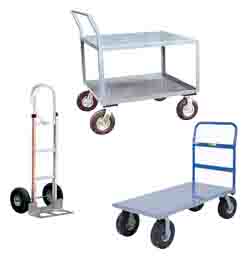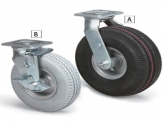 A lot of different types of materials handling equipment rely on casters or wheels to get the job done.
A lot of different types of materials handling equipment rely on casters or wheels to get the job done.
Casters and wheels come in many different sizes and materials. Plus, they attach to the materials handling vehicle or other devices in different ways.
For example, casters and wheels used on furniture dollies are typically bolted individually onto the bottom of the devices, while the wheels used on two-wheeled hand truck usually share a common axle and are held in place with a pin.
And wheels used on office chairs usually have a post that fits into a holder at the bottom of the chair’s base.
Shopping for New Casters and Wheels
Many people will simply buy replacement casters and wheels from the original manufacturer of the equipment needing repair. It’s faster, easier, and most convenient in most cases.
But you probably will end up paying a lot more for OEM casters from the device’s manufacturer than you would for universal casters or wheels. In many instances, casters and wheels are interchangeable, so you don’t necessarily have to pay full price for replacements.
A better plan is often to use the caster’s reorder number — generally found on the caster itself or in the Owner’s Manual of the equipment it is used on — to search online for a cheaper yet similar replacement. Incidentally, if you can’t find the owner’s manual, most makers of materials handling equipment have downloadable versions available on their websites.
What If There’s No Reorder Number?
 If the reorder number is not available, then you can use the caster’s or wheel’s dimensions to find a replacement. These dimensions also should be available in the paper or downloadable owner’s manual. Or you can measure it the old fashioned way with a ruler or tape measure, although this will be less accurate.
If the reorder number is not available, then you can use the caster’s or wheel’s dimensions to find a replacement. These dimensions also should be available in the paper or downloadable owner’s manual. Or you can measure it the old fashioned way with a ruler or tape measure, although this will be less accurate.
When reordering wheels and casters, it’s usually a good idea to get a couple of spares just to have around for when you need them in the future. That way, the next time a caster breaks or a wheel is ruined, you don’t have to go through the whole process of reordering all over again.
If your equipment budget allows it, on some pieces of equipment it’s also a good idea to replace all the casters or wheels if something goes wrong with one of them. This ensures they will all wear at the same rate, rather than have one new caster and three old, worn ones.
